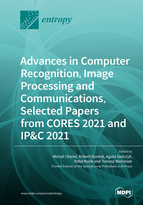Advances in Computer Recognition, Image Processing and Communications, Selected Papers from CORES 2021 and IP&C 2021
A special issue of Entropy (ISSN 1099-4300). This special issue belongs to the section "Signal and Data Analysis".
Deadline for manuscript submissions: closed (8 October 2021) | Viewed by 46572
Special Issue Editors
Interests: pattern recognition; machine learning; AI; security; cybersecurity
Special Issues, Collections and Topics in MDPI journals
Interests: machine learning; pattern recognition; AI; business intelligence
Interests: image processing; biometrics; machine learning
Special Issues, Collections and Topics in MDPI journals
Interests: pattern recognition; cybersecurity; AI
Special Issues, Collections and Topics in MDPI journals
Interests: telecommunication; networks; IoT
Special Issues, Collections and Topics in MDPI journals
Special Issue Information
Dear Colleagues,
The 12th International Conference on Computer Recognition Systems (CORES) and the 12th International Conference on Image Processing and Communications (IP&C) will be held on June 28–30, 2021, in Bydgoszcz, Poland. The websites of the event are listed below:
http://ipc-conference.utp.edu.pl/
The goal of both CORES 2021 and IP&C 2021 is to gather researchers and high-quality advancements in theoretical and practical aspects of computer recognition, pattern recognition, image processing, machine learning (shallow and deep), including papers in the areas of modern telecommunications and cybersecurity.
Authors of selected papers from the conference will be invited to submit extended versions of their original papers and contributions under the conference topics (new papers closely related with the conference themes are also welcome).
The scope includes but is not limited to the following:
- Classification and interpretation of text, video, voice
- Statistical, soft and structural methods of pattern recognition
- Image processing, analysis and interpretation
- Features extraction and selection
- Machine learning
- Trends and relations recognition and analysis
- Data and Web mining
- Machine-oriented knowledge representation and inference methods
- Knowledge-based decision support systems
- Advanced signal processing methods
- Special hardware architecture
- Applications
- Biometrics
- Cyber Security
- Next Generation Networks
- Optical Backbone and Access Networks
- Network Reliability
- New Services in IP Networks
- QoS in IP Networks
- Regular Structures of Communications Networks
- Web Applications
- IoT
- Cloud/Edge and Fog Networks
Prof. Dr. Michal Choras
Prof. Dr. Robert Burduk
Dr. Agata Giełczyk
Prof. Dr. Rafal Kozik
Dr. Tomasz Marciniak
Guest Editors
Manuscript Submission Information
Manuscripts should be submitted online at www.mdpi.com by registering and logging in to this website. Once you are registered, click here to go to the submission form. Manuscripts can be submitted until the deadline. All submissions that pass pre-check are peer-reviewed. Accepted papers will be published continuously in the journal (as soon as accepted) and will be listed together on the special issue website. Research articles, review articles as well as short communications are invited. For planned papers, a title and short abstract (about 100 words) can be sent to the Editorial Office for announcement on this website.
Submitted manuscripts should not have been published previously, nor be under consideration for publication elsewhere (except conference proceedings papers). All manuscripts are thoroughly refereed through a single-blind peer-review process. A guide for authors and other relevant information for submission of manuscripts is available on the Instructions for Authors page. Entropy is an international peer-reviewed open access monthly journal published by MDPI.
Please visit the Instructions for Authors page before submitting a manuscript. The Article Processing Charge (APC) for publication in this open access journal is 2600 CHF (Swiss Francs). Submitted papers should be well formatted and use good English. Authors may use MDPI's English editing service prior to publication or during author revisions.
Keywords
- computer recognition
- pattern recognition
- image processing
- telecommunications
- machine learning








